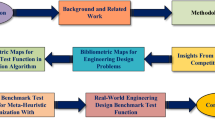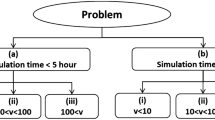Abstract
Currently, geometric over-constraints detection is of major interest in several different fields. In terms of product development process (PDP), many approaches exist to compare and detect geometric over-constraints, to decompose geometric systems, to solve geometric constraints systems. However, most approaches do not take into account the key characteristics of a geometric system, such as types of geometries, different levels at which a system can be decomposed e.g numerical or structural. For these reasons, geometric over-constraints detection still faces challenges to fully satisfy real needs of engineers. The aim of this paper is to review the state-of-the-art of works involving with geometric over-constraints detection and to identify possible research directions. Firstly, the paper highlights the user requirements for over-constraints detection when modeling geometric constraints systems in PDP and proposes a set of criteria to analyze the available methods classified into four categories: level of detecting over-constraints, system decomposition, system modeling and results generation. Secondly, it introduces and analyzes the available methods by grouping them based on the introduced criteria. Finally, it discusses possible directions and future challenges.























Similar content being viewed by others
Change history
02 August 2021
A Correction to this paper has been published: https://doi.org/10.1007/s11831-021-09633-3
References
Falcidieno B, Giannini F, Léon JC, Pernot JP (2014) Processing free form objects within a Product Development Process framework, vol 1. ASME-Press, New York, pp 317–344
Cheutet V, Daniel M, Hahmann S, La Greca R, Léon JC, Maculet R, Ménegaux D, Sauvage B (2007) Constraint modeling for curves and surfaces in CAGD: a survey. Int J Shape Model 13(02):159
Gouaty G, Fang L, Michelucci D, Daniel M, Pernot JP, Raffin R, Lanquetin S, Neveu M (2016) Variational geometric modeling with black box constraints and DAGs. Comput Aided Des 75:1–12
Graver J, Servatius B, Servatius H (1993) Combinatorial rigidity. Graduate studies in mathematics. American Mathematical Society, New York
Laman G (1970) On graphs and rigidity of plane skeletal structures. J Eng Math 4(4):331–340
Podgorelec D, Žalik B, Domiter V (2008) Dealing with redundancy and inconsistency in constructive geometric constraint solving. Adv Eng Softw 39(9):770–786
Foufou S, Michelucci D, Jurzak JP (2005) Numerical decomposition of geometric constraints. Proceedings of the 2005 ACM symposium on solid and physical modeling. ACM, pp 143–151
Sitharam M, Zhou Y (2004) A tractable, approximate, combinatorial 3d rigidity characterization. Fifth Automated Deduction in Geometry (ADG)
Jermann C, Neveu B, Trombettoni G (2003) Algorithms for identifying rigid subsystems in geometric constraint systems. In: 18th International Joint Conference in Artificial Intelligence, IJCAI-03 (No CONF, pp 233-238)
Latham RS, Middleditch AE (1996) Connectivity analysis: a tool for processing geometric constraints. Comput Aided Des 28(11):917–928
Ait-Aoudia S, Jegou R, Michelucci D (2014) Reduction of constraint systems. arXiv:1405.6131
Hu H, Kleiner M, Pernot JP (2017) Over-constraints detection and resolution in geometric equation systems. Comput Aided Des 90:84–94
Diestel R (2017) Graph theory. GTM 173, 5th edition, Vol 173. Springer, Heidelberg Graduate Texts in Mathematics
Welsh D (2010) Matroid theory. Dover books on mathematics. Dover Publications, New York
Michelucci D, Foufou S (2006) Detecting all dependences in systems of geometric constraints using the witness method. In: International Workshop on Automated Deduction in Geometry, pp 98–112. Springer, Berlin
Coxeter HSM, Greitzer SL (1967) Geometry revisited, vol 19. Maa, New York
Peng X, Chen L, Zhou F, Zhou J (2002) Singularity analysis of geometric constraint systems. J Comput Sci Technol 17(3):314–323
Fudos I, Hoffmann CM (1997) A graph-constructive approach to solving systems of geometric constraints. ACM Trans Gr (TOG) 16(2):179–216
Brüderlin B, Roller D (eds) (2012) Geometric constraint solving and applications. Springer Science & Business Media
Hoffmann CM, Sitharam M, Yuan B (2004) Making constraint solvers more usable: overconstraint problem. Comput Aided Des 36(4):377–399
Hoffmann CM, Lomonosov A, Sitharam M (1997, October). Finding solvable subsets of constraint graphs. In: International Conference on Principles and Practice of Constraint Programming. Springer, Berlin, pp 463–477
Dulmage AL, Mendelsohn NS (1958) Coverings of bipartite graphs. Can J Math 10:517–534
Fritzson P, Bunus P (2002, April) Modelica—a general object-oriented language for continuous and discrete-event system modeling and simulation. In: Proceedings 35th Annual Simulation Symposium. SS 2002, IEEE, pp 365–380
Serrano D (1987) Constraint management in conceptual design, Doctoral dissertation, Massachusetts Institute of Technology
Strang G (2014) Linear algebra and its applications. Elsevier Science
Light RA, Gossard DC (1983) Variational geometry: a new method for modifying part geometry for finite element analysis. Comput Struct 17(5–6):903–909
Okunev P, Johnson CR (2005) Necessary and sufficient conditions for existence of the LU factorization of an arbitrary matrix. arxiv:math/0506382
Dongarra J, Kennedy K, Messina P, Sorensen DC, Voigt RG (1990) Proceedings of the Fourth SIAM Conference on Parallel Processing for Scientific Computing, Chicago, Illinois, USA. SIAM 1990, ISBN 0-89871-262-9
Cox D, Little J, OShea D (2013) Ideals, varieties, and algorithms: an introduction to computational algebraic geometry and commutative algebra. Springer
Bose NK (2013) Multidimensional systems theory and applications. Springer
Chou SC (1988) An introduction to Wu’s method for mechanical theorem proving in geometry. J Automat Reason 4(3):237–267
Wu WT (2012) Mechanical theorem proving in geometries: basic principles. Springer
Cox DA, Little J, O’Shea D (2015) Ideals, varieties, and algorithms. Springer, New York, pp 49–119
Hoffmann CM (1989) Geometric and solid modeling: an introduction. Morgan Kaufmann Publishers Inc., San Francisco
Kondo K (1992) Algebraic method for manipulation of dimensional relationships in geometric models. Comput Aided Des 24(3):141–147
Chou S (1988) Mechanical geometry theorem proving. Mathematics and its applications. Springer, New York
Gao XS, Chou, SC (1998) Solving geometric constraint systems. II. A symbolic approach and decision of Rc-constructibility. Comput Aided Des 30(2):115–122
Haug EJ (1989) Computer aided kinematics and dynamics of mechanical systems, vol 1. Allyn and Bacon, Boston, pp 48–104
Krantz S, Parks H (2012) The implicit function theorem: history, theory, and applications. Modern Birkhäuser classics. Springer, New York
Michelucci D, Foufou S (2006) Geometric constraint solving: the witness configuration method. Comput Aided Des 38(4):284–299
Moinet M, Mandil G, Serre P (2014) Defining tools to address over-constrained geometric problems in computer aided design. Comput Aided Des 48:42–52
Michelucci D, Schreck P, Thierry SE, Fünfzig C, Génevaux JD (2010). Using the witness method to detect rigid subsystems of geometric constraints in CAD. In: Proceedings of the 14th ACM symposium on solid and physical modeling. ACM, pp 91–100
Michelucci D, Foufou S, Lamarque L, Schreck P (2006) Geometric constraints solving: some tracks. In: Proceedings of the 2006 ACM symposium on solid and physical modeling. ACM, pp 185–196
Thierry SE, Schreck P, Michelucci D, Fünfzig C, Génevaux JD (2011) Extensions of the witness method to characterize under-, over-and well-constrained geometric constraint systems. Comput Aided Des 43(10):1234–1249
Kubicki A, Michelucci D, Foufou S (2014) Witness computation for solving geometric constraint systems. In: Science and information conference (SAI), 2014. IEEE, pp 759–770
Zou, Qiang, and Hsi-Yung Feng (2019) On Limitations of the Witness Configuration Method for Geometric Constraint Solving in CAD Modeling. arXiv:1904.00526
Zou Q, Feng HY (2020) A decision-support method for information inconsistency resolution in direct modeling of CAD models. Adv Eng Inform 44:101087
Pernot JP, Falcidieno B, Giannini F, Léon JC (2008) Incorporating free-form features in aesthetic and engineering product design: State-of-the-art report. Comput Industry 59(6):626–637
Acknowledgements
The authors are grateful to the China Scholarship Council (No. 201406090176) for supporting this research.
Author information
Authors and Affiliations
Corresponding author
Ethics declarations
Conflict of interest
The authors declare that they have no known competing financial interests or personal relationships that could have appeared to influence the work reported in this paper.
Additional information
Publisher's Note
Springer Nature remains neutral with regard to jurisdictional claims in published maps and institutional affiliations.
Rights and permissions
About this article
Cite this article
Hu, H., Kleiner, M., Pernot, JP. et al. Geometric Over-Constraints Detection: A Survey. Arch Computat Methods Eng 28, 4331–4355 (2021). https://doi.org/10.1007/s11831-020-09509-y
Received:
Accepted:
Published:
Issue Date:
DOI: https://doi.org/10.1007/s11831-020-09509-y




